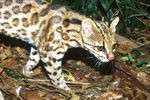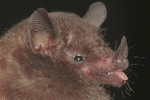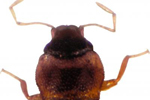In Brazil’s Baturite Mountains, scientists have uncovered a new species of prehensile-tailed porcupine, according to a new paper in Revista Nordestina de Biologia. Dubbed, the Baturite porcupine (Coendou baturitensis), the new species was discovered when scientists noticed significant differences between it and its closest relative, the Brazilian porcupine (Coendou prehensilis). The name prehensile-tailed refers to these porcupines long, mobile tail which they use as a fifth limb to adroitly climb trees.
The Baturite porcupine “was discovered after a careful review of the medium and large mammals from northeastern Brazil. First of all, we noted a very different shape of the skull of a porcupine collected at the Baturite Range. Then, we examined several specimens from different localities of porcupine, especially of the Coendou prehensilis, the closest species. […] Besides the skull difference, We found some characteristics of the skin unique to these animals and had not been found in any other so far,” the lead author, Anderson Feijó, told mongabay.com. The new species is darker with differently colored quills than its near-relative.

Close view of the new porcupine species, the Baturite porcupine: Coendou baturitensis. Photo by: Hugo Fernandes-Ferreira.
The Baturite porcupine inhabits montane forests in northeastern Brazil, and is so far only known from the Brazilian state of Ceará. According to the authors many of the species in the high-altitude forests differ from those found in the semiarid Caatinga forests on the plans below.
“For this reason, It’s very important protect this region,” says Feijó, who notes that the new porcupine is likely threatened. However, the scientists need more data before than they can definitively classify it.
Interestingly this is actually the second new prehensile-tailed porcupine (in the Coendou genus) to be described in Brazil this year. In April, scientists announced the discovery of the hope porcupine (Coendou speratus). Found in the Atlantic Forest, the scientists say this new species is in grave danger of extinction as 95 percent of its habitat has been lost and it continues to be hunted by locals.
Porcupines are large rodents known for their bristling quills, which keeps predators at bay. With these two new species, there are over 30 porcupine species worldwide.

The Baturite porcupine has a bulbous nose. Photo by: Hugo Fernandes-Ferreira.

Note the prehensile tail on the Baturite porcupine. Photo by: Hugo Fernandes-Ferreira.

The Baturite porcupine lives in the trees. Photo by: Hugo Fernandes-Ferreira.
Citations:
- Anderson Feijó and Alfredo Langguth. A new species of porcupine from the Baturité range. (2013) Revista Nordestina de Biologia 22 (1/2): 124-126
- Pontes et al (2013). A new species of porcupine, genus Coendou (Rodentia: Erethizontidae) from the Atlantic forest of northeastern Brazil. Zootaxa 3636 (3): 421–438 http://dx.doi.org/10.11646/zootaxa.3636.3.2
Related articles
Sky islands: exploring East Africa’s last frontier
,-South-Pare-Mts.-Tanzania.150.jpg)
(12/04/2013) The montane rainforests of East Africa are little-known to the global public. The Amazon and Congo loom much larger in our minds, while the savannas of East Africa remain the iconic ecosystems for the region. However these ancient, biodiverse forests—sitting on the tops of mountains rising from the African savanna—are home to some remarkable species, many found only in a single forest. A team of international scientists—Michele Menegon, Fabio Pupin, and Simon Loader—have made it their mission to document the little-known reptiles and amphibians in these so-called sky islands, many of which are highly imperiled.
Scientists discover new cat species roaming Brazil

(11/27/2013) As a family, cats are some of the most well-studied animals on Earth, but that doesn’t mean these adept carnivores don’t continue to surprise us. Scientists have announced today the stunning discovery of a new species of cat, long-confused with another. Looking at the molecular data of small cats in Brazil, researchers found that the tigrina—also known as the oncilla in Central America—is actually two separate species. The new species has been dubbed Leopardus guttulus and is found in the Atlantic Forest of southern Brazil, while the other Leopardus tigrinus is found in the cerrado and Caatinga ecosystems in northeastern Brazil.
New bat species discovered in Brazil leaves another at risk

(11/15/2013) A team of researchers has discovered a new species of bat in Brazil, which has put a previously known species, Bokermann’s nectar bat (Lonchophylla bokermanni), at risk of extinction. Long thought to comprise one species, the bat populations of the Atlantic Forest and the Cerrado – the tropical savannah of Brazil’s interior – are in fact distinct from one another, according to a new study in Zootaxa. Scientists now say the Atlantic Forest’s population represents a newly described species, which they have dubbed Peracchi’s nectar bat (Lonchophylla peracchii).
Newly discovered beetles construct private homes out of leaf holes and feces

(11/12/2013) Scientists have discovered two new species of leaf beetles in southern India that display a novel way of using leaf holes and their fecal pellets to build shelters – a nesting behavior previously not known among leaf beetles. Discovered in the forests of the Western Ghats in the states of Karnataka and Kerala, the scientists have named these pin-head sized leaf beetles Orthaltica syzygium and Orthaltica terminalia, after the plants they feed on: Syzygium species (e.g., the Java plum) and Terminalia species (e.g., the flowering murdah).
Five new, cryptic bats discovered in Senegal

(11/11/2013) An international research team led by Daurina Koubinova has discovered five new species of vesper bats during a series of expeditions to Senegal’s Niokolo-Koba National Park. The new species are considered cryptic, because their genetic makeup is different despite physical similarities. The new bats have yet to be named.
Adorable baby olinguito photographed in Colombia (picture)
(11/01/2013) Researchers returning from an expedition to a cloud forest in Colombia have released photos of the world’s most recently-discovered carnivore, the olinguito.
DNA tests reveal new dolphin species (photos)
.150.jpg)
(10/30/2013) With the help of DNA tests, scientists have declared a new dolphin species that dwells off the coast of northern Australia. The discovery was made after a team of researchers looked at the world’s humpback dolphins (in the genus Sousa), which sport telltale humps just behind their dorsal fins. While long-known to science, the new, as-yet-unnamed species was previously lumped with other humpback dolphins in the Indo-Pacific region.
New species of beetle discovered in megacity

(10/30/2013) When imagining the discovery of a new species, most people conjure thoughts of intrepid explorers, battling the odds in remote rainforests. But this needn’t be the case, at least according to a new study published in Zookeys. The study reports the discovery of a new species of water beetle in the heart of the 10th largest megacity in the world: Manila, Philippines.